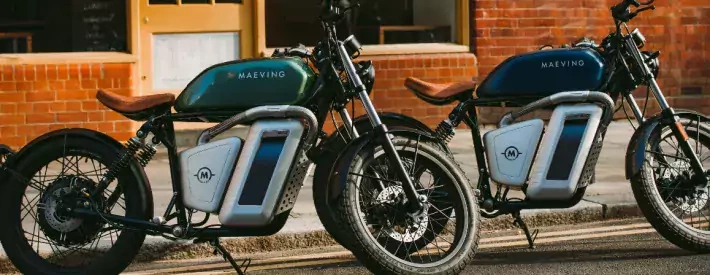Anatomy of a successful automotive start-up

How British electric bike manufacturer Maeving delivered where others have failed
If somebody emailed me a year ago and said they were from a British start-up building a brand new all-electric retro-futuristic cafe racer with an 80-mile battery range, I’d probably have ignored it. As a journalist covering the automotive industry, my inbox is littered with precisely this kind of vaporware – bikes and cars that look good in 3D renders, but will probably never make it into production due to the sheer complexity of doing so.
What makes Maeving, which has successfully (and punctually) delivered its first RM1 electric motorbikes this year, different to the countless other startups that come and go without ever selling a product? How did this small British firm avoid all of the hurdles that thwart so many of the newcomers to our industry? And how can others learn from it?
“It was the first thing we discussed when we started the business,” admits Sebastian Inglis-Jones, one of Maeving’s founders. “When we did our market research in the first instance, we were getting a bit panicky – it felt like every day in the press there’d be another electric motorbike announced, similar to the product that we were envisaging.
“We were worried ours wouldn’t work, because there were a million companies offering better range than we felt it was possible to achieve. But then we learned to ignore these reports.
“We spotted a pattern: it was always an engineer, who would design or concept a beautiful product, and – prior to doing enough due diligence and testing of the electronics and powertrain – they would raise a little money through a crowdfunding platform and some pre-sales. Then a load of people would get excited, and of course it would take twice as long and cost twice as much, and the company folds.”
“My business partner and I come from the commercial side, and approached it from a commercial standpoint,” continues Seb. “We decided not to fall into that trap, instead putting together a business plan, raising capital, creating a product, doing all the testing, and only then going out into the world – when the product actually exists. We were in complete stealth mode, until the point at which we had the product ready to hit the market.”
But can a product exist without hype? Cultivating interest among the public seems almost like the first step in launching anything automotive, with teaser videos and embargoed announcements often arriving years before the actual launch does. Even established manufacturers such as JLR and VW pour millions into marketing way ahead of the car being ready. Can start-ups be successful in a PR vacuum?
“We didn't do the usual thing that some businesses do, where you see the concept three years in advance,” says Seb. “People only found out about the product when we were actually ready with the product. And by then we already had a list of people who wanted to buy it. So that's also why we sold our first production straight away.”
Talent delivers success
Maeving’s RM1 is a beautiful machine, reflecting both the aesthetic purity of vintage motorcycles and the minimalist elegance associated with lightweight electric propulsion. Weighing less than 100kg, and with a power output equivalent (in a regulatory sense) to that of a 125cc, it really is an impressive machine. But this is no brainchild of a lone engineer.
“We definitely succeeded with the people we hired. Our team was probably the most talent-dense team in the country. For me, I think the combination of approaching it from a kind of commercial perspective, with a little bit more of an understanding of the costs associated with starting a business, and then hiring a very experienced engineering team from the outset, helped get us where we are.
“The first person we recruited once we got our investment was Graham Gilbert, from Triumph. I think startups trying to cobble together a team often end up with varying experience, but what we did was we've hired people who have a considerable amount of experience. Our head of procurement [Neville Thomas] was at Triumph, Polestar, LEVC – this is someone who’s one of the best people in the game. He comes on board and suddenly we’re having conversations with Bosch, which doesn’t normally work with startups.
“They’ve decided to do so because they know members of the team, because they like the look of the bike and because it’s a topical time. They’ve come over for testing and have been waxing lyrical about it. They actually have one of our bikes over at their offices. And now Greenway makes our batteries.”
“There’s a domino effect. Hiring Graham [Gilbert] meant that we could hire Neville [Thomas] which meant we could get Bosch on board and then Greenway, and suddenly we had a fantastic supplier base as well as the team of 21. It’s a testament to hiring experienced people instead of cheaper, less experienced people.”
Maeving has been exceptionally successful thus far, though in a sense it has only just left the start line; shipped units are still in double figures, and it will need to continue to deliver in order to become profitable. But with its veteran engineers, world-class suppliers and team of genuine businessmen at the helm, Maeving and its RM1 could be one of those exciting start-ups that one day, silently, becomes just another company.




